Fact box at the bottom is the key to the map of Tassie
A Tasmanian November is all about long days and warm weather. The season’s fishing has really started to heat up in tandem with the seas and waterways. Warm afternoons are reminding us of just why we love Tasmania so much. A laid back lifestyle and no traffic to be concerned with means a swift knock off from work and a short drive to a fishing hole somewhere.
All types of fishing are really building on the momentum we gained in October. Last month we still saw some indifferent weather and wind and it will be nice to see that settle down. In October, I managed to get out and find a few flathead for the table. Getting on the water with my young son was fantastic and I managed to show him the charms of a good ol’ fashioned flatty drift. You can give this technique a bit of a modern lift with good electronics – but more on that later. When I was a lad, warm days out off the coast drifting around for flathead was an event to look forward to. As a junior angler I normally fished land-based, but my best friend’s dad had a boat! Being invited out on a trip was better than Christmas!
The method to chase southern sand flathead has changed little in all the time I have enjoyed fishing. These tasty morsels can be found all around Tasmania. They tend to prefer depths of 0-35m over the sandy bottom. Great news for us is that they are commonly inshore in warmer months. Make a decision as to where you think the fish are and at what depth and make a start. I like to be fairly systematic, start out deep and slowly work my way in trying to find a good patch of fish. In the Bass Strait in November I would start in around 30m.
The best conditions to prospect for flatty are calm seas with no chop and just a slight bit of wind to aid in a nice drift. A bit of a drift allows you to cover more ground while establishing where good fish are situated. Should conditions worsen you can increase the amount of lead you have on your rig or use a drift bag. Once you start to lose contact with the bottom your peaceful day of fishing is just about done. You can have some good results in marginal conditions by tripping your bail arm and letting line out to keep baits of jigs in good position. This kind of fishing is alright out with mates, but if you’re fishing with kids or beginners it would be best when the weather turns to look for some shelter or call it a day.
If you aren’t achieving good results after a little while consider moving in shallower. No need to go from one extreme to the other though, I prefer to do little hops towards the shore and check for action along the way.
The good thing about flatty fishing is that the tackle and rods you already have will do the job even if you don’t have a lot of it.
The occasional angler who is not going to fish over 40m will get by with any rod and reel combo under 7ft long. Boat rods are a lot easier to handle if they are around 5ft long and can be even shorter if kids are to use them effectively. If you are looking to re-spool something lying around the shed for flathead fishing get some 40lb braid. This will allow you to feel the lightest of nibbles and also hold you in a good position should a gummy shark take a fancy to your presented bait. Paternoster rigs are the go-to rig for a good flatty catch. You can tie your own in some mono or buy some pre made ones from a friendly tackle store. I recommend doing both as it is important to keep your skills up to date and by practicing my own I can remember how to do twisted dropper knots for that one time I get stuck without some store bought models. You will need a nice range of sinkers from 12oz down. I don’t use the 12oz but if you start thinking you need them to hold bottom and start rattling around the sinker box looking for them, it’s probably time to call it quits.
Flathead fishing is all about the serenity and the laidback nature of the process. Find a good spot, drop bail arm, hit the bottom, close bail arm and place finger on line awaiting a bite. You should not have to wait long if you find them. Flathead are aggressive little blighters and will have a crack at most offerings. They will fall to bait, a huge range of artificial offerings, and a combination of both. Flasher rigs, jig-ems, and soft plastics can be deadly on their day. If you’re traveling a bit slowly, get some good hooks loaded with fresh bait down on the bottom and see if that is the key to unlocking their jaws. I have a good friend who likes to hedge his bets and puts a little piece of bait on his 2 hook paternoster rigs threaded with soft plastics.
My personal preferred method is to drop a paternoster down running circle or octopus style hooks on a soft tipped rod. Place this rod in a rod holder and then fish in hand a different soft plastic set up. I cast this out, let it sink to the bottom and work it back along the bottom to the boat. This allows me to cover more ground. If the bait rod goes off, sit the soft plastic set up in a rod holder while you reel it in. If you are in a good spot, by the time you have sorted out that first fish there will be something having a real go at your soft plastic. It can be hectic, but it always lots of fun. If the kids are aboard it keeps them amused for a good while.
Just to really ask for some pandemonium why not set a couple of squid jigs up at the front and rear ends of the boat. Should you get involved in a hot bite it might look like two samurais having a sword fight, but with squid ink and flatty spikes the weapons of choice.
A good drift is a run in the current or wind driven movement that pushes you onto a good patch of fish. Today we have two modern tools that can help you locate your drift and track the good patches of fish as you find them.
Logging waypoints is the best way to repeat good catches. Logging waypoints and naming them has become far easier with the systems from Navico some of the best on the market. Lowrance and Simrad units are very easy to navigate and the touch screen functionality leaves no excuse not to name waypoints. They have the added amazing function of Insight Genesis. This function gives a sonar reading of your own personal and favourite fishing grounds and have them generated into mapping detail far greater than that available on generic cards.
Use your sounders to your advantage and they will reward you. If you get several drifts going, name your waypoints and use different icons over separate drifts, you may see a pattern forming and work out why they are there and where they might be located elsewhere.
The above techniques generally apply to king or tiger flathead although it is important to step up the tackle and gear to the increased depth where they are found. Big kings are found in deeper water to 160m. Confusingly though they can be found in sheltered areas as shallow as 10m as well. Predominantly discovered in the deeper water around Tasmania but often in better numbers off the south and east coasts.
Due to the increased depth and use of bigger sinkers to attain and stay on the bottom, rods can be beefed up to 10-15kg line weight rating. Braid is a must for these deeper circumstances. The feel and connectivity to what’s going on at the wet end is amazing. Reels can range between 7000 and 9000 sizes.
After being closed for two months, November opens the striped trumpeter season. As these fish are a favourite for many, there will be plenty of anglers with smiles on their faces this month. These fish are fun to locate and catch and a spectacular table fish. Stripeys will now be the main focus of offshore fishos until the albacore and mako sharks arrive in January. These fish live on reefs in around 100m of water just inside the continental shelf. They can be found closer inshore for those that are prepared to search and put some time in.
A good sounder is again the first thing on the list to locate suitable structure, then a heavy paternoster rig and squid bait on a 13/0 circle hook. Get all your ducks lined up in a row and you should find fish. This is another form of fishing that demands the feel and sensitivity that braid delivers. The by-catch can be nearly as good as the main prize. Good sized jackass morwong and the occasional large gummy shark are welcomed.
The activity in the water along with the occasional bit of bait over the side can have a mako shark turn up out of the blue so be ready for that and have a suitable outfit and leader ready to go. I love a good Stripey fishing trip. They are tremendous fun to catch and pull hard once they nail your bait and head for home. To catch striped trumpeter on jigging outfits has become more and more popular. The jig outfit does not need to be expensive to get the job done. The only area to spend a few dollars on is some quality braid. This allows the lighter jig presentation to cut down through the water quickly and not have the braid catch current. Sea conditions are usually very good while fishing for Stripey and make for enjoyable days. When the weather turns foul and you have to back up on lines behind the boat to hold bottom, it’s time to head home!
As the weather warms, so does the water and the surf beaches will now be good spots to target flathead and salmon. These conditions will continue throughout November. Around the full moon the gummies come into the shallows at night to feed. Beach fishing is a fabulous evening pastime and one you can also enjoy with your kids on a Friday or Saturday night. Set the car up and get a good spot with a few comforts and it’s a magic time to share. Good lighting and some nibbles will see you fish well into the night and with a bit of luck some nice fish to show for your effort.
Australian Salmon will inhabit our coastline in increasing numbers as we move into the summer months. They are great sport and good fun on lighter gear and are accessible from the shore as well as by boat. A particularly deadly and fun way to target these fabulous fighting fish is by kayak. Taking them on head to head and having them leap and splash about is quite exciting. Get them cleaned and iced down and they alright to eat fresh. They do make is very tasty base for Thai fish cakes!
Nice big garfish are coming inshore to spawn and they too will be mincing around the sheltered bays. A little bit of fine berley in the water and some bread busted up on the surface will have them come and find you. Use light gear for these tasty little slender barrels. Small j-hooks and a pencil float is amazing fun for kids, but remind them to keep an eye on the float! Your little berley trail will also draw the attention of some silver trevally. If your berley starts to see some love, leave the kids to tackle the small fry and bounce a bigger plastic in underneath the action. Although a tad early for yellowtail kingfish – who normally come through when the water temperature gets north of 16°C – it doesn’t hurt to try something! Worst thing you could do is find a snapper!
Not enough is known about when and where the snapper are or when they will be at their thickest as of yet. Building up that knowledge by heading out and having a crack is the best bet. Try to find spots based on what worked last year and build on that. We will be trying a few spots along the north west coast in November and I hope to have something to report for you all as the action heats up in December. Fishing at anchor with a berley bucket over the side is a good way to start or start some pilchards for cubing and plop a few over every now and then. Google snapper rigs and give a few different ones a go out either side of the boat. Patience and more patience. It takes a little time to substantiate a berley trail so don’t get tired of it too quickly. Once you have picked a likely looking spot. Tough it out and give the berley a chance to do its job. Take a book or listen to the radio. Remember it’s the unwatched rod that will buckle over.
The Derwent is again performing well and fishing superbly. This will continue throughout November. Anglers will start to head further upstream as the whitebait start to wane late in November. I spent some time chasing sea runners in the Forth River in October and they were in sensational form. Good trout to 4lb driving fish up into the shallows and feeding on them. Bait showered out of the water surface with an ominous bow wave pushing under them. A trout stalker’s delight.
November can be a fly fisher’s best and worst time. Everything starts to happen on the dry fly front, but what technique to try? Hatching Duns are well underway all across the state and into the highlands. If conditions get muggy and a little overcast the mayflies will be on to get airborne and off the water’s surface. These little chaps will be in big numbers on highland lakes and are the favoured snack by hungry trout. What can really put the trout off is very bright weather or extreme cold. The good news is we should be seeing very little ‘extreme cold’ in November as we head full speed into the coming of summer.
Get out, be safe and find fish!
I have mentioned the weather is on the improve big time here in Tasmania in November. This has us feeling fresh and energetic about blowing out the cobwebs left over from the winter months. A great way to get outdoors and feel alive is to go boating. Tasmania has some spectacular and sometimes underused waterways and boating destinations. Recently, Mozz and I decided to take our very young sons on an overnight trip away in his new boat.
Some parent may think that sounds like too much hard work, but the joy on the faces of kids when included in such an adventure is reward enough for any perceived difficulties. Mozz’s son is 4 and my little Mason is 6 and they were super excited once we mentioned “an island”, I’m sure they thought there would be pirates and treasure to be found.
Planning is of great importance when taking small children onto the ocean. Safety and comfort need to be addressed if you are not to make your life a misery while away. Simplicity is the key here. Don’t overthink what you need and pack light but smart. Food can be kept simple and make sure you have plenty of water and of sunscreen. Coming home with a lobster red junior will spark some heated discussion and frowns.
Weather is a huge part of enjoying a day or trip away on a boat and this is even more so when kids are involved. Boating for the uninitiated can be a bit daunting and the dreaded seasickness can ruin great plans. The worst thing you can do is break someone new to boating with a rough trip. This goes for adults and kids alike. Make sure the weather looks good a couple of days out, and check again the afternoon before. If it looks like the weather has all turned to poo it can be a good idea to cancel or shape the trip to another more sheltered location.
We picked an awesome location and Mozz watched the weather like a hawk all week. He pulled the trigger on the trip the Thursday before and she was go time. I mentioned the trip to my son Mason and he was super excited. It was the last day of school for the term so I pulled him out just after lunch that Friday and we were off.
Mozz had decided we would fish the flathead grounds in the Mercury Passage and this can be accessed in a number of ways. We chose to travel to Triabunna just out off Orford on Tasmania’s South East coast. Triabunna has some new launching facilities and allows quick and easy access to Mercury Passage and Maria Island. Our plan was to fish our way down towards Lachlan Island and make camp on the anchor in Chinamans Bay.
The trip was a great success and we managed to find some nice flathead as we drifted across the sandy bottom. The two young boys mixed catching flatties with some fun in the sun and had a ball. We pulled stumps early and made our way to where we would be spending the night. The spot Mozz had chosen is a well-known anchorage and will often see a number of motorboats and yachts taking advantage of its sheltered aspect. The corner often used is tucked right in around to the north and is called Encampment Cove.
We were lucky enough to come across some mates from our Game Fishing club set up and very well settled in. They had brought across a heap of camping gear and were staying 2 weeks on Maria Island. Maria Island is a national park and a very popular tourist destination. The boat was moored and we enjoyed the hospitality of the Hammersley, Hartland and Hicks clans. Once off the boat the boys were in a nature wonderland and were taken under the wing of the older kids on the island. This allowed Adrian and I to more the boat fore and aft and once happy… wet our whistle. The wildlife is abundant on Maria and both young boys loved seeing their first Tasmanian devil and wombat up close.
The Maria Island area is a fantastic fishery and over the coming months all of the favourite sport and table fish will and can be caught from around its shores. There is a small marine reserve on the northern tip to be aware of. Sand flathead in the shallows are found across all the sandy bottoms in the area and the bigger king or tiger flathead in the deeper zones. Gummy sharks will be moving in and staying for a while in the warmer shallows. Once the water temperature rises in late November the yellowtail kings will frequent the rocky points.
We had a great evening on shore and made our way to the boat for the boys’ first night sleeping on a trailer boat. There was some concern they may need some settling, but this was far from the truth. They had enjoyed a sensational fun filled day of wide-eyed new experiences and they did not take much rocking.
We woke to one of the most pristine and still mornings you could ever hope for and weighed anchor for an early fish. We had to be back in Hobart by 1pm so we fished for a while, picking up some more nice flathead and some squid. When it was time to head off we left some time to take a leisurely tour across to Rheban and up past Orford and back into the safe harbour of Triabunna.
All in all a wonderful trip that we both said we must do again real soon. The kids had the time of their lives and are also super keen to be involved and go again. This is due to Mozz’s planning, picking the weather and an awesome boat.
TASMANIAN FLATHEAD HOTSPOTS (See Map)
Southern Sand Flathead
| Marion Bay | 1 |
|---|---|
| Mercury Passage | 2 |
| Wynyard | 3 |
| Sisters Beach | 4 |
| Bridport | 5 |
| Port Sorrel | 6 |
King or Tiger Flathead
| Off Pirates Bay | 7 |
|---|---|
| Bicheno | 8 |
| Off Schouten | 9 |
| Tomahawk | 10 |

Mason caught this flathead on his great grandfather’s 60-year-old rod in the Mercury Passage.
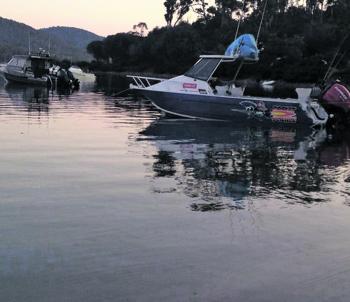
All anchored up and ready for the evening.

The boys has an absolute ball camping and fishing,
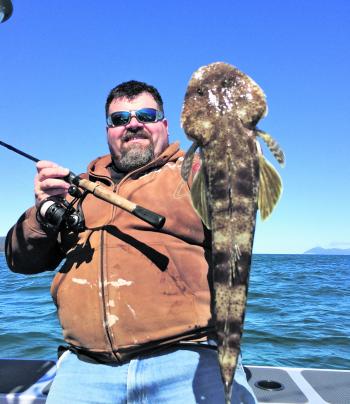
Hooch caught this flatty working a 4” Nemesis in 11m of water with trout gear in the mouth of Chainman’s Bay
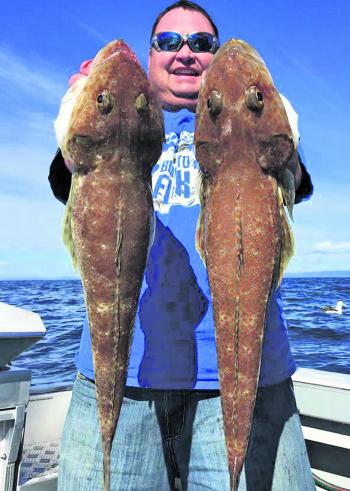
King flathead caught off Bicheno.

Stupendous striped trumpeter! Anglers will be making the most of the open season in November.
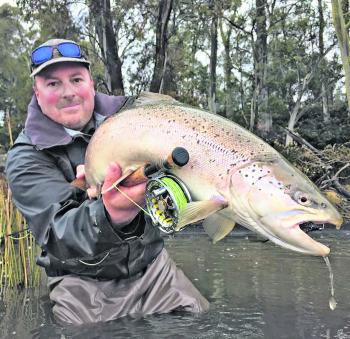
Chunky brown trout can be a handful, especially at this size!
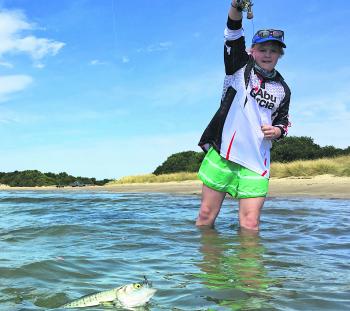
Slippery salmon put up a good fight on fly gear.
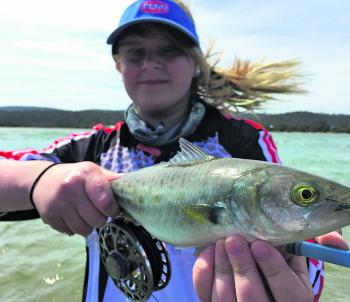
Happy anglers are what it’s all about!
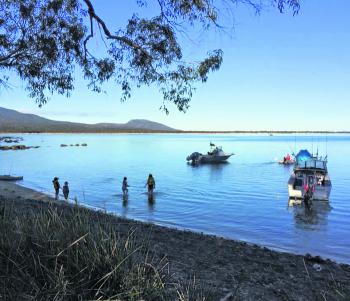
Encampment Cove is an excellent place to anchor up and camp.

The still, pristine mornings are something you can expect in Tassie’s South East.




